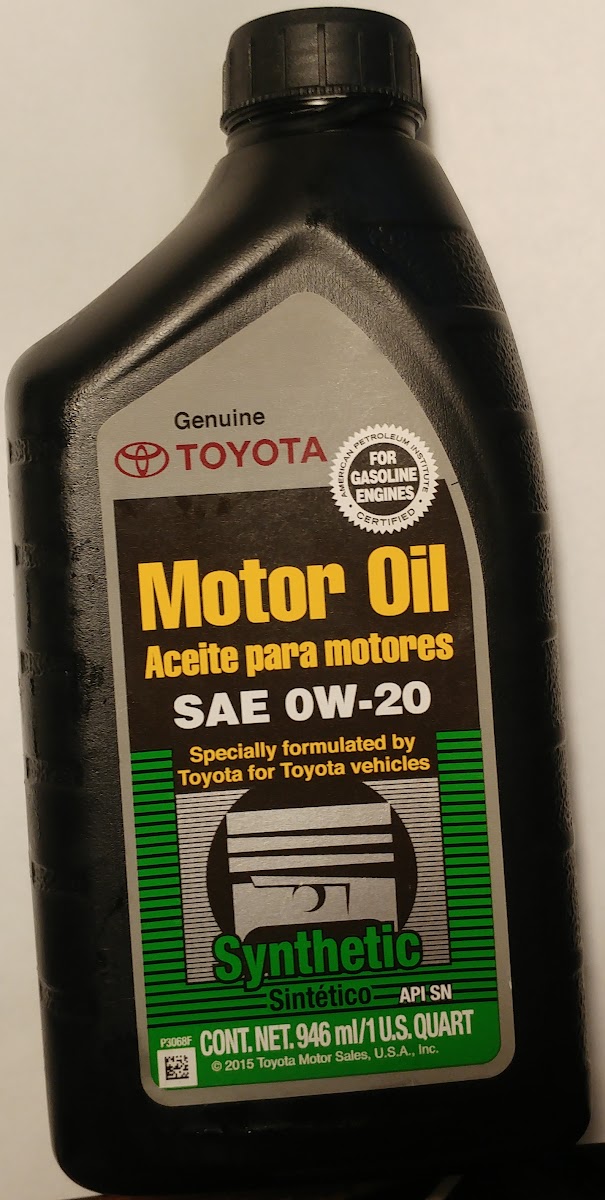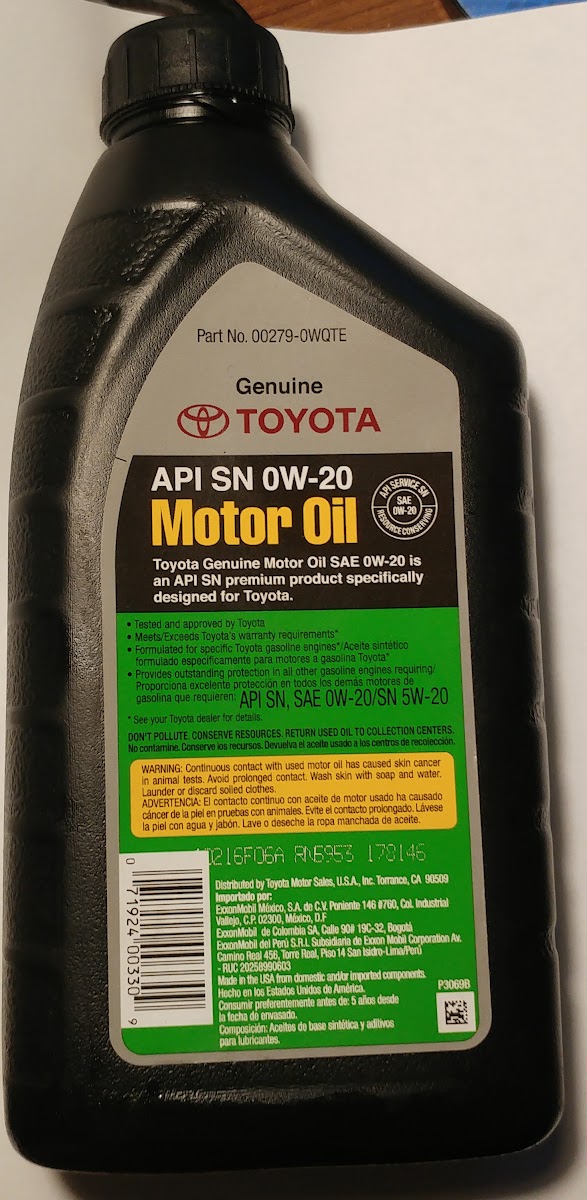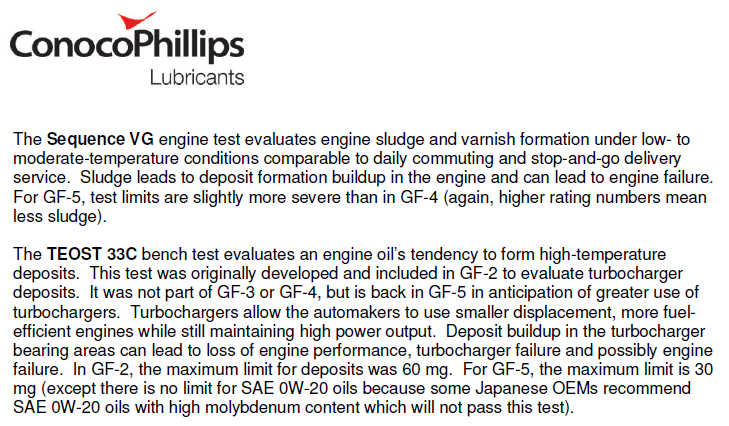They have made TGMO great again.
It's been six years and one month since I reviewed (link) the original formulation (link) of TGMO 0W-20 SN, made in the USA by ExxonMobil. I was very impressed by this oil at the time.
Oils have evolved a lot since then and so has our knowledge. Yesterday I found out that PQIA has tested the TGMO (link) and I was excited because I could finally calculate its base-oil-quality index (BOQI). When I visited the page, I was in total shock -- the formulation has entirely changed for the better!
(1) The moly! It's 787 ppm now, readily kicking any oil in the rear.
(2) The hybrid detergent system: Ca/Mg ratio a little over 2 (1470 ppm/674 ppm). This is the modern detergent system for two important reasons: (a) It prevents LSPI. (b) Mg doesn't neutralize all types of acids while Ca does; so, you get the best of both worlds -- Mg helps retain TBN high as it lasts longer and Ca ensures everything is neutralized, therefore resulting in both long-lasting and complete protection against all acids.
(3) Boron (197 ppm) is still there!
(4) Unbeaten viscosity index VI = 227! Yes, we all have reservations toward the viscosity-index improver (VII), but a high VI is always a good thing.
(5) Last but not least, the base-oil-quality index BOQI = 66, beating all oils including Pennzoil Platinum with PurePlus, except Mobil 1, Genuine Nissan Motor Oil (GNMO) by ExxonMobil, and Amsoil Signature Series! This BOQI clearly points to a high percentage of GTL base stocks. Of course, there is no way to rule out some GTL/PAO blend as well but there is certainly not much Group III in the blend. This is supported by the fact that the recently introduced Genuine Nissan Motor Oil (GNMO) 0W-20 and TGMO 0W-16 also made by ExxonMobil are known to be 75% and 100% GTL, respectively (GNMO MSDS and ExxonMobil MSDS). Note that we don't know the exact base-stock balance but nevertheless BOQI = 66 indicates a very high-quality base oil. Also note that the VII depresses the BOQI somewhat and as a result TGMO's BOQI is probably somewhat depressed by the high VII content.
Code:
Rank BOQI DV-35 NOACK Date purchased Oil
1 84.3 4,110 10.10 2014/02/16 Mobil1 Synthetic API SN, ILSAC GF-5, SAE 0W-20 motor oil
2 83.3 3,928 10.70 2015/12/28 Mobil 1 Full Synthetic SAE 0W-20 dexos1
3 81.9 4,316 9.90 2018/01/25 Genuine Nissan Full Synthetic SAE 0W-20 Motor Oil
4 80.4 5,122 8.50 Amsoil PDS AMSOIL Signature Series Synthetic Motor Oil 0W-20 (ASM)
5 78.2 4,182 10.70 2017/03/06 Mobil 1 Advanced Fuel Economy Full Synthetic SAE 0W-20 dexos1
6 66.1 4,102 12.90 2018/01/24 Genuine Toyota Synthetic SAE 0W-20
7 59.0 5,929 10.00 2018/03/12 SuperTech High Mileage Full Synthetic SAE 0W-20 Motor Oil
8 57.8 5,884 10.30 2017/03/06 Pennzoil Platinum Full Synthetic with PurePlus™ Technology SAE 0W-20 dexos1
9 57.1 6,068 10.10 2015/12/28 Pennzoil Platinum Full Synthetic SAE 0W-20 dexos1
10 54.9 5,958 10.70 2014/02/06 Quaker State Synthetic API SN, ILSAC GF-5, SAE 0W-20 motor oil
11 54.0 5,448 11.90 2015/04/01 Beck/Arnley Premium OE Fully Synthetic SAE 0W-20
12 54.0 5,949 10.90 2018/03/12 Royal Purple Synthetic Oil SAE 0W-20 High Performance Motor Oil
13 53.2 5,721 11.50 2015/12/28 Valvoline Full Synthetic SYNPower SAE 0W-20
14 53.0 5,006 13.20 2015/12/28 SuperS SuperSyn Full Synthetic SAE 0W-20
15 51.9 5,819 11.60 2017/03/06 Valvoline Full Synthetic SYNPower SAE 0W-20 dexos1
16 51.7 5,642 12.00 2018/01/24 ACDelco Synthetic SAE 0W-20
17 51.2 5,342 12.80 2017/12/09 Honda Full Synthetic SAE 0W-20 Motor Oil
18 49.8 5,537 12.70 2015/12/28 Castrol Edge Full Synthetic SAE 0W-20 dexos1
19 49.5 5,996 11.80 2017/03/07 O'Reilly SAE 0W-20 Full Synthetic dexos1 Motor Oil
20 48.6 5,451 13.20 2014/08/14 Castrol Edge Synthetic Motor Oil API SN, ILSAC GF-5, SAE 0W-20 motor oil
21 47.6 5,658 13.00 2015/07/27 STARFIRE SAE 0W-20 Full Synthetic dexos1
22 47.2 5,657 13.10 2014/02/07 Pronto Supreme API SN, ILSAC GF-5, SAE 0W-20 motor oil
23 47.2 4,981 14.90 2014/08/25 Starfire Motor Oil API SN, ILSAC GF-5, SAE 0W-20 motor oil
24 46.2 5,786 13.10 2015/12/28 ProLine Full Synthetic SAE 0W-20 dexos1
25 45.6 5,113 15.00 2014/12/01 i-Sint XL 4AM Synthetic SAE 0W-20, API SN, ILSAC GF-5
26 44.9 5,647 13.80 2017/12/09 i-Sint XL 4AM Synthetic Engine Oil SAE 0W-20
27 43.5 6,138 13.10 2017/03/06 STP SYN Full Synthetic SAE 0W-20 dexos1
28 43.1 5,723 14.20 2016/01/25 AMSOIL Synthetic OE SAE 0W-20 Motor Oil
29 41.8 5,814 14.40 2014/02/07 MAG1 API SN, ILSAC GF-5, SAE 0W-20 motor oil
30 39.7 6,163 14.30 2014/08/11 Federated Motor Oil API SN, ILSAC GF-5, SAE 0W-20 motor oil
Certainly TGMO is getting ready for the ILSAC GF-6/API SP era. This oil will probably be relabeled when these specs become official in late 2019 or early 2020.
I was eager to put the new TGMO 0W-20 SN in my engine but then I was thrilled to realize that I have already been running this high-moly GTL reformulation of TGMO for over 3,000 miles and over a year without knowing it! As for the driving impressions, I don't remember my engine running as smoothly ever, and at full throttle the engine doesn't seem to strain at all. Also, I've been wondering why this oil hasn't deteriorated after many repeated short trips for over a year -- it still feels like new oil -- and now, I know it's not the old TGMO but a substantially higher-quality formulation with high moly content and a GTL base oil. The UOA will be very interesting. Will it live to the hype? Stay tuned!
Finally, I know you are asking -- how do I identify the new formulation and how do I get it and for how much? The new formulation says "Sintético" on the front and has the ExxonMobil codes P3068F and P3069B on the front and back, respectively.


As for the price and availability, you could get it very cheap if you can successfully negotiate with the Toyota dealer. Here is the current MSRP and offer from a Toyota dealer:
TradeMotion Carson Toyota
It's been six years and one month since I reviewed (link) the original formulation (link) of TGMO 0W-20 SN, made in the USA by ExxonMobil. I was very impressed by this oil at the time.
Oils have evolved a lot since then and so has our knowledge. Yesterday I found out that PQIA has tested the TGMO (link) and I was excited because I could finally calculate its base-oil-quality index (BOQI). When I visited the page, I was in total shock -- the formulation has entirely changed for the better!
(1) The moly! It's 787 ppm now, readily kicking any oil in the rear.
(2) The hybrid detergent system: Ca/Mg ratio a little over 2 (1470 ppm/674 ppm). This is the modern detergent system for two important reasons: (a) It prevents LSPI. (b) Mg doesn't neutralize all types of acids while Ca does; so, you get the best of both worlds -- Mg helps retain TBN high as it lasts longer and Ca ensures everything is neutralized, therefore resulting in both long-lasting and complete protection against all acids.
(3) Boron (197 ppm) is still there!
(4) Unbeaten viscosity index VI = 227! Yes, we all have reservations toward the viscosity-index improver (VII), but a high VI is always a good thing.
(5) Last but not least, the base-oil-quality index BOQI = 66, beating all oils including Pennzoil Platinum with PurePlus, except Mobil 1, Genuine Nissan Motor Oil (GNMO) by ExxonMobil, and Amsoil Signature Series! This BOQI clearly points to a high percentage of GTL base stocks. Of course, there is no way to rule out some GTL/PAO blend as well but there is certainly not much Group III in the blend. This is supported by the fact that the recently introduced Genuine Nissan Motor Oil (GNMO) 0W-20 and TGMO 0W-16 also made by ExxonMobil are known to be 75% and 100% GTL, respectively (GNMO MSDS and ExxonMobil MSDS). Note that we don't know the exact base-stock balance but nevertheless BOQI = 66 indicates a very high-quality base oil. Also note that the VII depresses the BOQI somewhat and as a result TGMO's BOQI is probably somewhat depressed by the high VII content.
Code:
Rank BOQI DV-35 NOACK Date purchased Oil
1 84.3 4,110 10.10 2014/02/16 Mobil1 Synthetic API SN, ILSAC GF-5, SAE 0W-20 motor oil
2 83.3 3,928 10.70 2015/12/28 Mobil 1 Full Synthetic SAE 0W-20 dexos1
3 81.9 4,316 9.90 2018/01/25 Genuine Nissan Full Synthetic SAE 0W-20 Motor Oil
4 80.4 5,122 8.50 Amsoil PDS AMSOIL Signature Series Synthetic Motor Oil 0W-20 (ASM)
5 78.2 4,182 10.70 2017/03/06 Mobil 1 Advanced Fuel Economy Full Synthetic SAE 0W-20 dexos1
6 66.1 4,102 12.90 2018/01/24 Genuine Toyota Synthetic SAE 0W-20
7 59.0 5,929 10.00 2018/03/12 SuperTech High Mileage Full Synthetic SAE 0W-20 Motor Oil
8 57.8 5,884 10.30 2017/03/06 Pennzoil Platinum Full Synthetic with PurePlus™ Technology SAE 0W-20 dexos1
9 57.1 6,068 10.10 2015/12/28 Pennzoil Platinum Full Synthetic SAE 0W-20 dexos1
10 54.9 5,958 10.70 2014/02/06 Quaker State Synthetic API SN, ILSAC GF-5, SAE 0W-20 motor oil
11 54.0 5,448 11.90 2015/04/01 Beck/Arnley Premium OE Fully Synthetic SAE 0W-20
12 54.0 5,949 10.90 2018/03/12 Royal Purple Synthetic Oil SAE 0W-20 High Performance Motor Oil
13 53.2 5,721 11.50 2015/12/28 Valvoline Full Synthetic SYNPower SAE 0W-20
14 53.0 5,006 13.20 2015/12/28 SuperS SuperSyn Full Synthetic SAE 0W-20
15 51.9 5,819 11.60 2017/03/06 Valvoline Full Synthetic SYNPower SAE 0W-20 dexos1
16 51.7 5,642 12.00 2018/01/24 ACDelco Synthetic SAE 0W-20
17 51.2 5,342 12.80 2017/12/09 Honda Full Synthetic SAE 0W-20 Motor Oil
18 49.8 5,537 12.70 2015/12/28 Castrol Edge Full Synthetic SAE 0W-20 dexos1
19 49.5 5,996 11.80 2017/03/07 O'Reilly SAE 0W-20 Full Synthetic dexos1 Motor Oil
20 48.6 5,451 13.20 2014/08/14 Castrol Edge Synthetic Motor Oil API SN, ILSAC GF-5, SAE 0W-20 motor oil
21 47.6 5,658 13.00 2015/07/27 STARFIRE SAE 0W-20 Full Synthetic dexos1
22 47.2 5,657 13.10 2014/02/07 Pronto Supreme API SN, ILSAC GF-5, SAE 0W-20 motor oil
23 47.2 4,981 14.90 2014/08/25 Starfire Motor Oil API SN, ILSAC GF-5, SAE 0W-20 motor oil
24 46.2 5,786 13.10 2015/12/28 ProLine Full Synthetic SAE 0W-20 dexos1
25 45.6 5,113 15.00 2014/12/01 i-Sint XL 4AM Synthetic SAE 0W-20, API SN, ILSAC GF-5
26 44.9 5,647 13.80 2017/12/09 i-Sint XL 4AM Synthetic Engine Oil SAE 0W-20
27 43.5 6,138 13.10 2017/03/06 STP SYN Full Synthetic SAE 0W-20 dexos1
28 43.1 5,723 14.20 2016/01/25 AMSOIL Synthetic OE SAE 0W-20 Motor Oil
29 41.8 5,814 14.40 2014/02/07 MAG1 API SN, ILSAC GF-5, SAE 0W-20 motor oil
30 39.7 6,163 14.30 2014/08/11 Federated Motor Oil API SN, ILSAC GF-5, SAE 0W-20 motor oil
Certainly TGMO is getting ready for the ILSAC GF-6/API SP era. This oil will probably be relabeled when these specs become official in late 2019 or early 2020.
I was eager to put the new TGMO 0W-20 SN in my engine but then I was thrilled to realize that I have already been running this high-moly GTL reformulation of TGMO for over 3,000 miles and over a year without knowing it! As for the driving impressions, I don't remember my engine running as smoothly ever, and at full throttle the engine doesn't seem to strain at all. Also, I've been wondering why this oil hasn't deteriorated after many repeated short trips for over a year -- it still feels like new oil -- and now, I know it's not the old TGMO but a substantially higher-quality formulation with high moly content and a GTL base oil. The UOA will be very interesting. Will it live to the hype? Stay tuned!
Finally, I know you are asking -- how do I identify the new formulation and how do I get it and for how much? The new formulation says "Sintético" on the front and has the ExxonMobil codes P3068F and P3069B on the front and back, respectively.


As for the price and availability, you could get it very cheap if you can successfully negotiate with the Toyota dealer. Here is the current MSRP and offer from a Toyota dealer:
TradeMotion Carson Toyota



